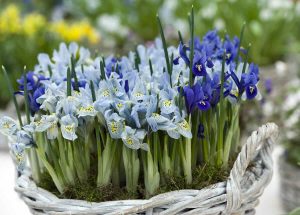
IT’S HARD TO THINK of another place so rich with major gardens as the Brandywine Valley in Chester County, Pa., and an adjacent portion of Delaware. Five of those gardens have a historic connection—a family connection—as they were all made by members of the du Pont family.
A new book, “Du Pont Gardens of the Brandywine Valley” (affiliate link) portrays the story of those places, and its photographer and writer took me on some virtual visits to these must-see gardens.
The book profiles five gardens created by generations of the du Pont industrial family—Longwood, Winterthur, and Mt. Cuba among them—in photographs by Larry Lederman and words by Marta McDowell, my guests.
Read along as you listen to the Oct. 16, 2023 edition of my public-radio show and podcast using the player below. You can subscribe to all future editions on Apple Podcasts (iTunes) or Spotify or Stitcher (and browse my archive of podcasts here).
the du pont gardens of the brandywine
Margaret: Marta, it’s good to talk to you again. I haven’t talked to you in a while, but I hope all as well in both of your worlds. It looks like you two did some garden visiting, and certainly studying up on some of these gardens. Because wow, it’s a big book full of photographs and text as well.
As I said in the introduction, the five gardens, it’s not like they’re related entities managed by the same organization or anything, are they? They’re related by human ancestry. Is that right, Larry?
Larry: Yes. They have their unique histories and different branches of the family. I spent about a year and a half photographing them, and I went down every two weeks and stayed for two or three days. When I went down, I had a place at Longwood where I could stay. It was actually my COVID project, so I started in 2021 in the spring. I usually like to start in the winter, but I took two springs to do this, because spring is such an important part of the gardens and the process. So that’s basically the arc of it, the experience.
Margaret: Right. Now, Marta, like Larry, you’ve both been to many gardens. I’ll ask both of you but I’ll ask Marta first: Do you guys think there’s any other that small an area geographically that really rivals the Brandywine Valley in terms of its… It has the nickname, “America’s Garden Capital,” right? It’s really amazing the riches of horticulture that are… I think there’s like 30 gardens within 30 miles of Philadelphia that are visitor-friendly types of places.
Marta: It is one of those beacons, Margaret. There are beautiful gardens all around the world, but this is really a concentration. I have a friend who just came up from North Carolina, and she went just to that area, and I think in two days saw 10 gardens and sort of had total overload. But it’s doable there.
Margaret: Yeah. Yeah. Larry, is there any other place you can think of that has such… I can’t come up with something, but…

Margaret: Yeah. So I want to talk a little bit about that. As you were just referring to, I think it says in the book that the five du Pont family gardens that are in this book cover more than 3,500 acres in total landscape, so between naturalistic areas, like woodlands and so forth, and formal gardens.
Today we know these places as public gardens, but they were private homes in this different era of times. So let’s talk just a little bit scene-setting. Because I think you write in the book, Marta, that it wasn’t the first du Pont who came from France—was he E.I. du Pont; did he come in 1800? It wasn’t the first du Pont who made all these gardens. It was grandchildren or great-grandchildren, I forget, but descendants. So it was a long lineage of garden-makers. Is that right?
Marta: Absolutely. They were all tree planters, I should say, and they all gardened to some extent. But the really great generation of garden-makers were those people in the really country-place era, so those first decades of the 20th century. The great du Pont fortunes had already been made, and they continued to work. So many of these garden-makers worked in various aspects of the du Pont Corporation. But they were exercising, I don’t know, they were flexingl they had this money, and this was one way that they expressed themselves, not the only way, but one important way.

So he was a determined garden-maker, for sure. Now, his garden, Larry, that is at Hagley, yes? [Above, the Crowinshield garden, at Hagley, is unrestored.]
Larry: That’s Hagley. Yes. What’s interesting is that in the book, we show a picture of the stone barn they built, which is huge. It’s monumental. It’s a bank barn, so that you can drive up or get a cart up into the second floor and so forth. It was in fact, when they started, basically their home, which they shared with the animals, and then they branched out and built the house, and then years later, they built the office.
Then the garden was very early, because they needed the food and the crops. So that in a sense, it’s a true American story in a way. It’s agrarian in that way. And yet, they then use the river to create this great industrial empire, because it is the power, that water power, which they use as the energy to move the mills, to move the turbines, and so forth.
Margaret: Larry, as a photographer, looking at Hagley—I haven’t been there, but I’ve read a lot about it, and I’ve talked to the person who’s charged with bringing it back—its bones are there, but a lot of it’s in ruin, almost. It’s not fancy… It doesn’t look like Longwood [laughter], let’s put it that way.
Larry: Well, it’s actually the most enticing in its own way. It has its industrial history. I had not been expecting when I got there to see the ruin which the Crowninshield family had built. They had built a fantasy world, where they had this Italianate garden, and you walked down from the house, and you walked into a classical environment with a huge gate, which they had taken parts of from Italy and so forth.
And they had statuary, and it has a classic quality to it, and it has an industrial quality to it, because they used the great iron steel cauldrons that were used in the mill to create ornaments and so forth.
So I was surprised by it when I got there, and it was raining that day, or it had been raining, and it had this kind of quality to it. The air and the light had this quality to it, a fog and so forth, and mystery. And they said, “Oh god, the weather’s not very good.” I said, “No, this is magnificent.” [Laughter.] I said, “It’s a fairy tale, and this is a way to tell it.”
Margaret: Yeah. So Marta, to write about it, it’s different from a lot of gardens, right? Because it’s not all gussied up. There are plants that still come back through all the overgrowth and whatever, things that were planted there a long, long time ago. This is an old garden, again, the remnant of an old garden. Right?
Marta: The wonderful thing about Hagley is, it’s really two gardens, and they’re on two sides of the old homestead, if you will, the original du Pont house. Up the hill from the house, there’s this French potager, and it’s in beautiful condition because it was restored, I think in the 1970s. It’s still beautifully tended, just what you’d expect. The espaliered fruit trees, and beautiful pruning, and all very precise.
Then if you go down the hill to the back of the house, you find this other garden that Larry’s describing, and it was created over 100 years after the first one. So again, this is the one created by that first du Pont, E.I. du Pont’s great-granddaughter—I’ve got my generations confused, too—and her husband, the Crowninshields.
It’s really, really magical. As Larry said, it’s either fairytale, or to me, it was kind of haunting. It’s vaguely in ruin. It’s a feeling in a garden that I have not had often. There was the the Lost Gardens of Heligan, which I saw once in Cornwall. It’s really nothing I’ve seen in the U.S. So it’s got so much potential. And as you say, part of this magic is, in the spring, the bulbs that Louise Crowninshield planted still come up and bloom. Some of the trees are there, so that’s very cool.
Margaret: Yeah, it’s very, very crazy. Yeah.You hinted at it before, Marta, you said something about “they were all tree-planters.” But I was thinking as I looked through the book and read through the book that it’s not just horticulture, and this was horticulture on a grand scale at these estates, but there’s also arboriculture. There’s the love and the care of trees and so forth. So Larry, as someone looking at these places, figuring out how to showcase them in photography, trees are such an important signature of these gardens, and they’re also such big characters in any photograph, yeah? So you must have had quite a time. There’s a lot of pictures that involve important trees, and allees of trees, and so forth. Yes?

So when I got down to Wilmington and looked at the trees, I couldn’t believe it. The basis for Longwood was Peirce’s Woods, which was a couple of hundred years old before Pierre bought it. And he bought it because he wanted to save the trees, and they had planted all kinds of specimen trees. So I had a field day there.
Then Winterthur has these wonderful trees, poplars, that are huge, and so does Mt. Cuba. In a way, I hadn’t seen trees like this before. The New York Botanical Garden has an allee of poplars, and because they’re all in a group, they wound up very, very branchy. But these trees really grow to the sky, and in the 19th century, they used to make masts for sailing ships.
So it gives you a sense of what was there, and what was there for the purposes of photography. Then in Winterthur, the one thing that Henry did was he created what was called the March Bank. He under-planted all these trees so that when March and the spring starts, the woodland just starts to become a fairy land.
Margaret: Yes, it does. It certainly does. It’s famous for that. Anyone who’s a garden lover should make a trip to this area, if only for that in the spring. But there’s so much spring going on. So you mentioned Pierre, and you mentioned Henry. So let’s just quickly, Marta, maybe you can help us, let’s just go through the five quickly, the five gardens. We’re talking Pierre du Pont and Henry du Pont and so forth. So we started with E.I. du Pont, who came from France in 1800, and he made the garden, built the place at Hagley and so forth. And that was the beginning. So the other four, who’s who in this mix?
Marta: O.K., so we’ll go to Pierre. Pierre Samuel du Pont created Longwood. His cousins included Henry Francis du Pont, who created Winterthur, and Louise du Pont Crowninshield, who created that other garden at Hagley. As well as Alfred du Pont, who creates Nemours.
Then one generation down, you have Lammot du Pont Copeland, who with his wife, Pamela Copeland, creates Mt. Cuba. So that’s the gang.
Margaret: So formality to informality, I am going to guess that… And again, none of them is informal. These are all grand places relative to how most of us live [laughter]. But I’m going to guess that I would put Mt. Cuba as the least formal landscape in a way, of all of these. And I don’t know which one I would say is the most formal. How would you guys rate them, which are…

I would say, as a woodland garden, which is interesting, I would say Winterthur is probably the most interesting of the gardens, as a woodland garden. Mt. Cuba, I would say, ranks next to it in that regard, because it has woodlands and natural lands. There’s about a thousand acres. And so that’s how I would rate it on that basis.
And Hagley is the least. It’s basically a family garden, really, and a museum in part. Did I cover everybody? I think I covered everybody. Yes. Longwood is a display garden. Pierre was a showman, so Longwood is a display garden. It has wonderful woods, it has everything. But the centerpiece is the fact that it has idea gardens and walks of flowers. In the book, you’ll see as far as the eye can see, there are photographs showing flowers.
Margaret: Yeah, yeah, no. I want to spend some of our time or a lot of our time that’s remaining talking about what you guys take away from doing a project where you focus on gardens of this scale and laden with this much history and so forth. Because obviously, again, most of us don’t have a landscape of this scale or of this history or any of the degree of formality in these.
So what are some of the things that—and Marta, we can start with you, we can go back and forth—really you think, “Wow, O.K., my place is really different, but that’s a lesson for me.” What are some of the takeaways that stand out in your mind?
Marta: I’m going to start with the hardest one [laughter], I think, and that was Nemours, which, it’s a French garden. So that isn’t my style of gardening, in this kind of, I don’t know, Versailles-esque style. Yet when I think about it, what Nemours offers—and a careful walk through Nemours, not just looking at the view and then going inside and saying, “O.K., we’re done,” but walking through—you find things that reveal themselves one at a time.
So you walk down this grand vista, and all of a sudden, you come to this maze garden, which wasn’t visible from above. Or you go down this grand allee of trees, the approach to the house, and you look to the side, and you realize that they’ve opened up windows, if we want to use a fancy word, it’s like “fenestrated,” where you get this peek, and you go, “Yeah, I could do that in my garden,” by positioning shrubs and trees in a certain way, or maybe putting up a trellis so that you have to go around it. So that’s one takeaway from Nemours.
Margaret: O.K. So that’s kind of a hide and reveal; “Don’t let me see the whole picture all at once.” That reminder for a gardener in any scale. O.K.
Marta: Absolutely.
Margaret: Yeah. Larry, do you have one that sticks out for you?

Then the gardens sort of fit into that kind of experience. So you take Nemours, it’s basically a grand surprise. You start at the top, and you have the sense, as Marta said, of having seen everything. But as you walk down what’s called “the long walk,” everything gets revealed.
In Longwood [above], you go from display to display to display to display. So it’s not really a… But there are lots of places to sit. So you can get there, you can walk, and you can sit.

And with Winterthur, what you have is, you have something which is decorated, but it is playful. For example, the Sundial Garden used to be the tennis court, and Henry couldn’t resist pulling it up and planting it. And there are all these gazebos around, so that you always have a sense of where things are in relation to everything else. So he organizes in a sense that garden, which is huge, by monuments in different places as far as you can see.
Margaret: I think for me, looking through the book, and all your great photographs, Larry, and reading the stories you’ve told of each garden, Marta, the other thing I feel is the power of formality against a naturalistic… As we’ve talked about, each of these places also has some woods or something; there are some parts that are less structured, less formal. The power of formality: It’s something that as we get wilder in our gardens and focused more on natives and so forth, I think it makes a great juxtaposition, even in a loose meadow, to have some formal element. Do you know what I mean?
Marta: Absolutely. So you take Mt. Cuba. Mt. Cuba does such a stellar job of studying and displaying plants of the Piedmont region, and yet it also has composition and focal points, right? It has something that draws your eye into it. It’s got paths that move you through it. As Larry says, you’ve got places to sit. It’s definitely got the compositional elements that we would call more formal. So that’s the thing to remember. Sometimes I see people doing valiant efforts at native-plant gardens or native-plant yards, and they haven’t quite remembered that part.
Margaret: Right, the structure. Right. Well, I could talk to you about these beautiful gardens a lot longer, but we’ve run out of time [laughter], and I want to congratulate you both. Larry, congratulations for making this happen, and Marta, for bringing it to life with the words, because the stories of these gardens are very interesting as well. So thank you both for making time today. I really appreciate it.
(All photos by Larry Lederman, from the book. Used with permission.)
prefer the podcast version of the show?






